

Table of contents
- Rare Flowers - list in alphabetical order
- Rare bulbs in alphabetical order
Picturesque beauty of flowers, such as orchid, meadow bellflower or checkered flower, are rare in the wild. Intensive agriculture and forestry has destroyed the habitat of numerous plant species, so that their appearance in the landscape is tantamount to a sensation. Nature-loving home gardeners no longer want to stand by and watch the disastrous process and plant rare flowers and bulbs. Get to know 20 types of flowers here that will transform your garden into a floral paradise and ecological gem.
Rare Flowers - list in alphabetical order
Arnica, real arnica(Arnica montana)
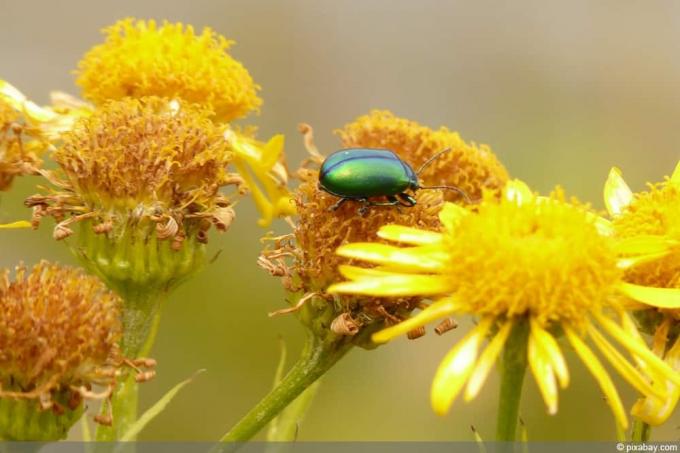
With yellow star blossoms, real arnica competes with the summer sun. The native medicinal plant has become rare because it is a specialist for acidic bog soil. In the course of the draining of swamps, the habitat of this pretty flower was lost. With its decorative, lush green leaf rosettes, arnica is also an ornament for moist, acidic locations in the garden when it is not in bloom.
- Flowering period: June to July
- Growth height: 30 cm
Blue Ladders to Heaven(Polemonium caeruleum)

In the wild you will look in vain for the sky-blue, upright flowering shoots of this historic perennial. With a bit of luck, the rare blue sky ladder can be discovered in sheltered floodplains and river valleys. If you still have a fresh, moist, nutrient-rich spot in the garden at the edge of the pond or in the middle of the wildflower meadow, this rare type of flower shows just how rich it is in bloom.
- Flowering period: June and July
- Growth height: 60 to 80 cm
Christmas rose(Helleborus niger)

White cup-shaped blossoms surrounded by ice and snow are the special characteristics of the Christmas rose. The secret winter queen among the flower species is unfortunately rare in the wild because there is a lack of suitable locations. The noble beauty wants a sunny to semi-shady place, which is characterized by fresh, moist, calcareous soil. Unfortunately, the innocent white of its beautiful flowers hides a poisonous side, so the Christmas rose should be kept out of the reach of children.
- Flowering time: November to March
- Growth height: 15 to 25 cm
diptam(Dictamnus albus)
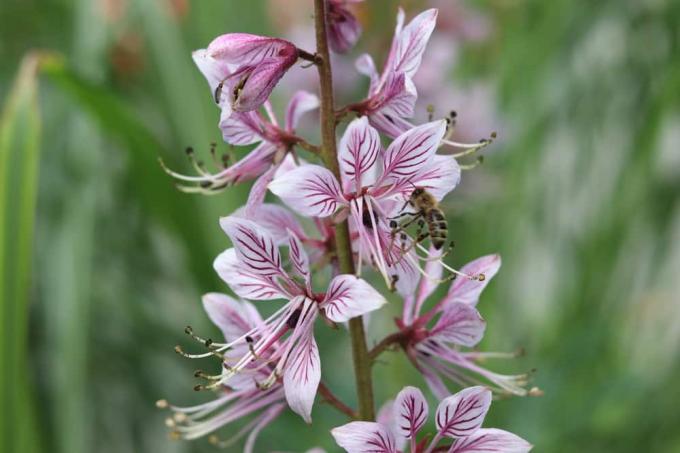
The great poet Johann Wolfgang von Goethe would read us the riot act from his grave if he heard that ruthless people were radically destroying the habitat of his favorite flower restrict. The native perennial is a real feast for the eyes with elegant pinnate leaves and pink flower clusters. The rare flower has been under protection since 1936 because it only thrives in sunny, warm, calcareous and well-drained soil. Wherever the picturesque rhombic plant feels comfortable, it gains in radiance from year to year and proves to be very durable.
- Flowering period: May to June
- Growth height: 80 to 100 cm
edelweiss(Leontopodium alpinum)

It didn't help the legendary edelweiss that it was the first plant in Germany to grow in the middle of the 19th century. Century was placed under nature protection. Despite all this, the star-shaped, silvery felt-like flowers are a rarity. In order to enjoy the floral emblem of the Alps in your own garden, integrate the rare Simply flower in the planting plan for the sun-drenched rock garden, a sunny wall crown or rock steppe. Ideally, you dedicate a separate alpinum to edelweiss, associated with the also rare flower species Alpine Auricula (Primula auricula) and Pasque Flower (Pulsatilla vulgaris)
- Flowering period: June to August
- Growth height: 10 to 15 cm
Lady's Slipper, Yellow Lady's Slipper(Cypripedium calceolus)
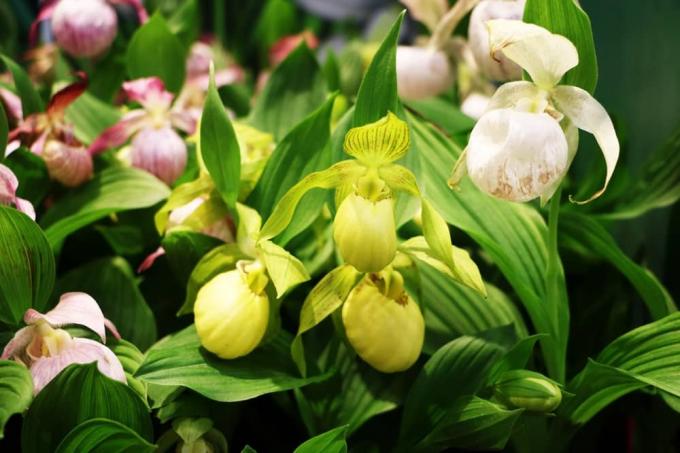
Yellow lady's slipper has already won the title "Orchid of the Year" twice, in 1996 and 2010, because nobody can deny its unique beauty. Probably the most magnificent wild orchid species is also the only lady's slipper species native to Europe. Thus, the rare flower obliges us to protect and preserve it. Light, herb-rich bushes, calcareous loam and clay soil and fresh, moist soil are the elixir of life for vital growth. In these locations, Frauenschuh presents its unmistakable, shoe-shaped flowers, to which it owes its name.
- Flowering period: May and June
- Growth height: 40 to 60 cm
Gold Flax, Yellow Flax(Linum flavum)
Parallel to the destruction of species-rich poor meadows, low-nitrogen bushes and pine forest edges, the yellow carpets of flowers of golden flax retreated. Today, the stock of these beautiful flowers has shrunk to a few hundred specimens. By planting yellow flax in your naturally cultivated garden, you are making a valuable contribution to preserving the sun-yellow flowers.
- Flowering period: June to August
- Growth height: 20 cm
poppy(Papaver rhoeas)
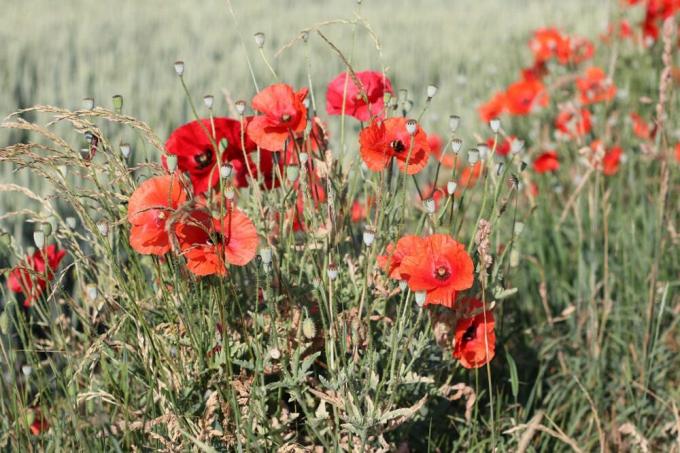
Bright red, extremely delicate cup blossoms announce from afar that you are encountering the rare corn poppy. Before pesticides caused the great extinction of species in the fields, the biennial summer flower was a familiar sight. In 2017, the Loki Schmidt Foundation drew attention to the threat of corn poppies by naming the plant "Flower of the Year". A specialty of the corn poppy is that it is not afraid to transform stony wasteland and desolate embankments into a sea of red flowers.
- Flowering period: May to July
- Growth height: 50 to 60 cm
cornflower(Centaurea cyanus)

In earlier years, blue cornflowers shaped the picture of extensive grain fields. Together with the bright red corn poppies, they were the dream team of midsummer. Unfortunately, the use of pesticides put an end to the romantic ambiance. As an annual summer flower, the cornflower with its richly branched stems can definitely compete with them the splendor of opulent perennials when the flower is sown in groups in a sunny, nutrient-poor location Location.
- Flowering period: June to October (please clean faded flowers regularly)
- Growth height: 50 to 70 cm
Pasque flower, pasque flower(Pulsatilla vulgaris)
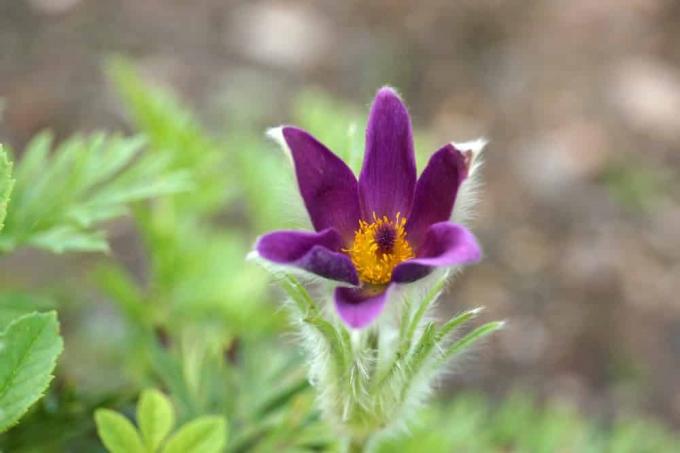
A herald of spring with a special charm is the pasque flower, whose half-open spring blossoms are reminiscent of the cow bells on the alpine pastures. Following the furious flowering period, the rare flower inspires with feathery seed heads, bulging with unique feather tails. Since the distinctive pasqueflower is very picky about the site conditions, it is threatened with extinction. The precious flower loves calcareous, sandy-humic soil and warm locations. Poor grassland, calcareous slate and gravel terraces are their territory.
- Flowering time: March to April
- Growth height: 20 cm
purple orchid(Orchis purpurea)

The increasing encroachment of semi-arid meadows and the disappearance of valuable forest biotopes is making life difficult for one of the most impressive orchids in Germany. As representative of all orchids, I would like to recommend the purple orchid, the orchid of the year 2013. Its magnificent flowers are composed of three upper, dark purple petals, enthroned like a helmet over the three lower, white, purple-spotted petals. A work of art created by Mother Nature, which is perfectly staged on the semi-shady, dry and warm edge of the wood.
- Flowering period: May and June
- Growth height: 25 to 80 cm
Redleaf Rose, Pike Rose(Rosa glauca)

Superficially, roses are not one of the rare types of flowers. However, the extravagant splendor of cultivated roses in ornamental gardens and parks has little in common with the unadulterated natural beauty of the protected red-leaf rose. The wild rose has become so rare in Germany that it is listed as a highly endangered species on the Red List. By including the pike rose with pink flowers and shimmering blue leaves in your planting plan, you can stop the decline. The decision is rewarded with a magnificent rose bush, up to 250 cm high, which requires little care.
- Flowering period: June and July
- Growth height: 150 to 250 cm
Tip:
The colorful dance of rare flowers not only contributes to the varied appearance of the garden. As a positive side effect, the floral rarities attract rare butterflies to your green realm, such as the copper butterfly, ducat butterfly or common blue.
Centaury, God's grace herb(Centaurium erythraea)

Where the lovely centaury likes it, it puts on such a dense pink flower dress that the green stalks can no longer be seen. However, suitable locations are few and far between in the wild, so the flower has become rare. A low level of competitiveness compared to neighboring plants makes matters worse. The native wildflower loves sunny to semi-shady locations with permeable, low-lime soil and does not want to be disturbed with a rake or additional fertilization.
- Flowering period: June to August
- Growth height: 20 to 30 cm
Globeflower, goldhead(Trollius europaeus)
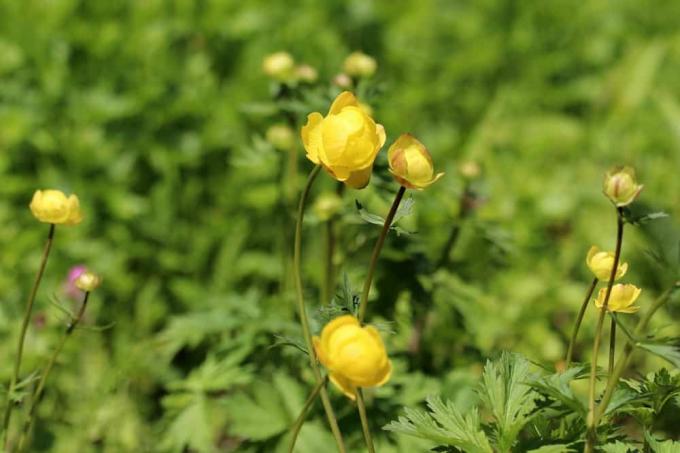
The extensive use of wet meadows and their draining has become the fatality of the only globe flower species in Europe. The flower of the year 1995 has been under nature protection since 2001 because its bright yellow balls of flowers have become increasingly rare. Up to 15 sun-yellow petals gather in a dense ball, allowing only small pollinators to get inside for the enticing nectar. A spectacle for the whole family is the attempt by fat bumblebees and bees to squeeze through the blossoms in order to get their hands on the delicious nectar.
- Flowering time: May to June (regular cleaning prolongs the flowering time)
- Growth height: 20 to 60 cm
Rare bulbs in alphabetical order
Squill, star hyacinth(Scilla bifolia)

The rich supply of nectar from the sky-blue flowers gives bees and butterflies a first source of food in spring. In a sunny, warm location, the squill develops a dense carpet of flowers in the natural garden within a few years. Although the bulb flower is very hardy, the stock is steadily declining, so that it is protected today. Give the rare flower a chance by planting the bulbs in large groups in the loose, humus-rich garden soil in autumn.
- Flowering time: March
- Growth height: 10 cm
Spring Light Flower, Light Mass Flower(Colchicum bulbocodium)
With the spring light flower, a very special treasure will find its way into your garden. The species of flower is so rare that great efforts are made to protect it when one of its few natural habitats is discovered. Its distinguishing feature is its six-petalled, purple to pink flowers that shine in close proximity to the ground. When the snow melts, 3 or more of the crocus-like flowers sprout from each flower bulb and last up to 3 weeks. The spring light flower cannot deny its botanical relationship with autumn crocuses, including the toxic components.
- Flowering time: February to April
- Growth height: 5 to 15 cm
checkered flower(Fritillaria meleagris)

The destruction of marshy meadows and riparian regions has led to the almost complete retreat of checkerboard flowers from the landscape. The flowers, with the distinctive combination of bellflowers, color and pattern, would be a major loss to biodiversity. If you plant small groups of the flower bulbs in the fresh, moist, nutrient-rich soil in autumn, your garden will be enriched by a host of charming heralds of spring. The checkered flower is also one of the few bulbs that like to thrive in the swampy banks of ponds and streams.
- Flowering time: April and May
- Growth height: 30 cm
Marsh iris, water iris(Iris pseudacorus)
With bright yellow iris flowers, the flag iris makes shallow water zones glow. The tubers can be up to a depth of 40 cm without being damaged by the permanent flooding. The early warning system in nature conservation was recently triggered for the yellow swamp beauty because a gradual retreat can be observed. The community of hobby gardeners braces itself against this beginning process and plants the Water iris, it is spared the fate of being included in the Red List of Extinct Flower Species to be included.
- Flowering period: May to July
- Growth height: 60 to 100 cm
Turk's cap lily(Lilium martagon)

Are you on the lookout for a rare flower that bursts into color against the dark backdrop of copses? Then shortlist the Turk's cap lily with its striking flowers and seductive fragrance. Their preference for cool, semi-shady locations is fatal for the stately lily family in the wild. In the course of global warming, the magnificent flower retreats to the cool mountains and is also becoming a rarity there.
- Flowering period: May and June
- Growth height: 100 to 120 cm
White Forest Hyacinth, Two-Leaf Forest Hyacinth(Platanthera bifolia)

One of the most beautiful wild orchids gracefully completes the series of rare flowers and flower bulbs. The white forest hyacinth inspires with flower spikes on which up to 40 flowers cavort. A typical feature is a long thorn, at the transparent end of which promising nectar can be seen with the naked eye. As a result of overfertilization, bush encroachment and afforestation, the bulb flower has already disappeared from the lowlands and has retreated to higher altitudes. To get the orchid of the year 2011, a light, sheltered spot in normal, humus-rich garden soil is sufficient, also under deciduous trees or in nutrient-poor grassland.
- Flowering period: June to August
- Growth height: 20 to 50 cm
 garden editorial
garden editorial I write about everything that interests me in my garden.
Learn more about Rose

Ground cover roses: care from A – Z
All varieties of ground cover roses are attractive plants with an abundance of flowers consisting of single or double, single or multicolored and delicately scented flowers. Sometimes they even bloom several times a year. They are a low-maintenance and pretty alternative to green ground covers.

Pruning & caring for wild roses | Instructions for Hundsrose & Co.
Wild roses are the easy-care archetype of the rose, but even they cannot do without care in the garden. With the right care, wild roses such as the dog rose or the apple rose produce lush flowers and can be used in a variety of ways in the garden.

Dune rose, burnet rose, Rosa pimpinellifolia - care instructions
The dune rose or burnet rose is a "rose for all occasions", which brings a wealth of the most beautiful flowers into the garden with the lowest demands. In the article you will learn how easy it is to take care of the versatile rose.

Take care of old roses - transplant and cut properly
Beautiful newly designed garden, only the old roses are now really in the way? Read how to properly transplant and cut old rose bushes.

Tufted rose, Rosa multiflora, Multi-flowered rose - care & pruning
Tufted rose, Rosa multiflora, multi-flowered rose - as the plant is also called, the flowers and the scent are simply attractive. In order for both to be preserved for a long time and to enrich the garden, the plant must also be cared for accordingly and trimmed regularly. With the right instructions, this is also possible for laypeople.

Potato rose, Rosa rugosa - care, cutting and propagation
The potato rose, originally native to East Asia, is also very popular in local gardens because it is quite robust due to its origin, because in addition to frost hardness, it also has a large salt tolerance, which is particularly important for a location in the front yard, since salt is often spread here in winter becomes.
